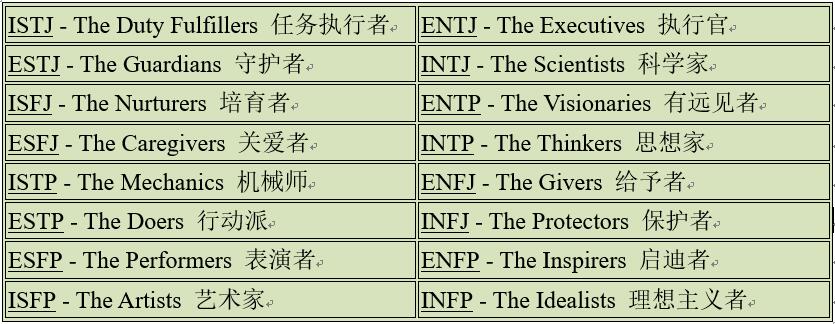内容简介
16.7 Personality Types and Career Choices 人格类型与职业选择
要点:
1. Personality Type Theory 人格类型理论
在1913年国际精神分析大会上,荣格提出个性的两种态度类型:内倾和外倾。1921年他在《心理类型学》一书中又作了详细的阐述,并提出了四种功能类型,即理性功能的相互对立的两种类型──思维功能与情感功能;和非理性功能的相互对立的两种类型──感觉功能和直觉功能。美国心理学家布里格斯和迈尔斯母女在荣格的两种态度类型和四种功能类型的基础上,又增加了判断和知觉两种类型,由此组成了个性的四维八极特征,它们彼此结合就构成了十六种人格类型。
2. 16 Personality Types 16 种人格类型
人格类型理论认为一个人的个性可以从四个角度进行分析,用字母代表如下:
驱动力的来源:外向E---内向I
接受信息的方式:感觉S---直觉N
决策的方式:思维T---情感F
对待不确定性的态度:判断J---知觉P
其中两两组合,可以组合成16种人格类型。
3. Animal Personality Types 动物与人格类型
1. INTP: 猫头鹰;2. ESTP: 狐狸;3. ISFP: 树懒;4. ENTJ: 狮子;5. ISFJ: 鹿;6. INTJ: 章鱼;7. ISTP: 猫;8. ESFP: 水獭;9. INFJ: 狼;10. ENFP: 海豚;11. ESTJ: 蜜蜂;12. ISTJ: 海狸;13. ENFJ: 狗;14. INFP: 猫鼬;15. ENTP: 鹦鹉;16. ESFJ: 大象
4. Common careers for different personality types 人格类型与职业选择

5. Jung Typology Test 荣格性格类型测验
人格类型理论认为,不同人格类型的人适合从事的职业不尽相同。基于人格类型理论的人格测试有助于发现不同个体最适合从事的职业,从而给他们的职业选择提供重要参考。


